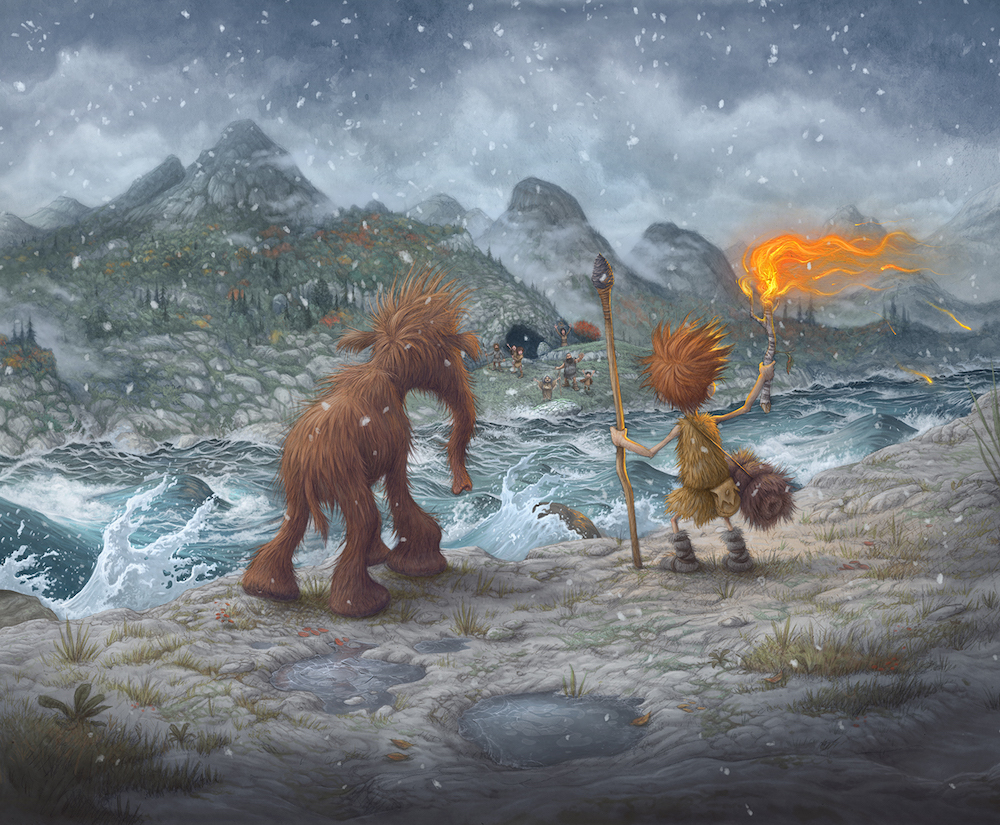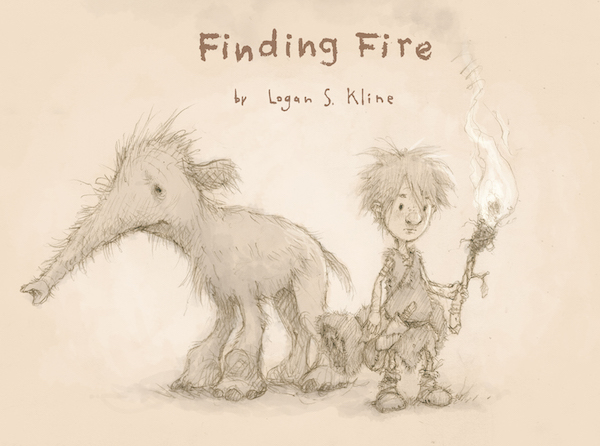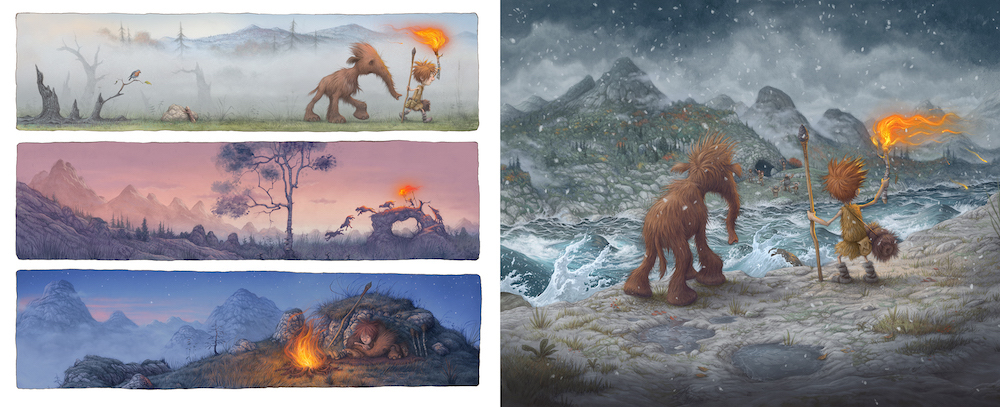
e: How do you approach your craft, and how might your thoughts or this book help readers do things or think about things differently?
Logan: When it comes to making a picture book I want to say something that may not sound right but I think that it is true; words and art do not need each other. There are many great books out there that do not need illustrations. There are many great works of visual art that would not be enhanced if we wrote a few choice words on them. That said, we obviously enjoy putting words and images together… we do it all the time… for lots of different reasons. The paradox of picture books is that you are trying to create a situation where two things that do not need each other, find themselves in a desperate need of one another. All for the sake of a task that can range from poignantly simple to gobsmackingly complicated… I’m talking about telling a story to small children. A demographic that is notoriously fickle and impatient (tough words, yes… but you know it’s true). The real challenge to the craftsmanship of the artist and writer is creating a situation that does not feel forced. For me, this comes as the result of a great deal of revision.

e: What was your creative process/medium, can you walk us through it?
Logan: Typically it starts with a graphite drawing, made up of mostly light outlines and strategically placed cross hatching. This drawing is then scanned at the highest resolution I can manage. After that, there are several digital techniques that are completed almost exclusively in Adobe Photoshop. The amount of layers I utilize is fairly extreme. My art director at Candlewick found my Photoshop files unusable (a fact that I devilishly take delight in). The detail you see above is from a file that is 11.68 gigabytes… for some unhealthy reason I take pride in that.


The traditional components of page 35 are scanned and digitally combined.
e: What was your path to publication?
Logan: Finding Fire started with a sketch of a Prehistoric child, a little boy. He had a lot of charm and charisma right off the bat (that is not always the case with the characters that I design). It only took a few attempts to get him ‘right’. He was a fusion of my two sons; my eldest's wild hair and my youngest’s wiry frame. In the beginning, this was accidental but I embraced it once I started rendering him in the way that he would appear in a finished illustration. After that, the basic story almost wrote itself…it just tumbled out of me in one quick session. It was rather organic and it blended a lot of my interests into one compact story. It was not long until I had a rough version sketched out in the form of a storyboard. Once it seemed to be working as a story, I let my agent know that I might have a picture book concept ready to go. I pitched her the idea, we reviewed the rough sketches and she agreed that I had something worth pursuing. It was two and a half years before we had a dummy book that was truly ready to submit to publishers. That may seem like a long time but keep in mind I was a full time teacher and I had two young sons that I was raising with my wife. And candidly, my agent (Ronnie) and I were keenly aware of the competitive market for picture books. If we received a rejection, it was not going to be because we were careless or made poor decisions about pacing or page turn. Oddly enough I worked really hard on the written aspect. Ronnie was always pushing me to reduce the word count, to boil the writing down to the most essential words. If only we knew at that time what was in store for the words of Finding Fire.

The first treatment of “the boy” and “the creature”. Taken from their first appearance in my sketchbook more than 5 years ago.
e: Is there a unique or funny story behind the creation of FINDING FIRE?
Logan: Yes, originally Finding Fire had words (throughout the entire book). Here’s an example of pages 34 & 35. The first version is from the dummy book that I submitted to Candlewick Press. You can clearly see that it had text. The second version is the spread as it appears in the finished book… wordless.


Originally Finding Fire was presented to publishers with words. The dummy book had 140 words used sparingly but throughout the entire book. The final published version has 30 words, all on the third page of the book.
My editor, Kaylan, started asking about the possibility of going “nearly wordless” shortly after we submitted the dummy book. I love wordless books so it’s rather amusing to me that I was so resistant to the idea. I take pride in my effort to explore all options when working out an illustration project. Yet after several requests I had to admit…I had not really explored the possibility of a wordless version of the book. What if that was the better version? So, I reworked the dummy book, removed all text (except the opening line) and showed the new nearly wordless version to my wife (who was in truth my first editor and art director). I still remember those first moments as she thumbed through the book “I hate to say it hun…it’s better without the words”. I took a deep breath and never looked back. Kaylan was right…the images told the story better.
Logan: I think my whole life has been an attempt to figure this out and after 45 years of making art, I can say with the utmost certainty; I have no idea whatsoever. Now don’t get me wrong, I have some strong instincts in regards to this endeavor but it is far from a science. I do know that everything I make, absolutely everything, is an attempt to produce what I think you are referring to as “heart art”. I’m really hoping my work connects with a variety of people and is cherished by them. I do not like the idea that someone would walk by my work and not pick it up. I work really hard to make artwork that is sincere and accessible.

The very first illustration I created for my picture book, Finding Fire.
e: How do you advertise yourself (or do you)?
Logan: With a lot of discomfort and awkwardness. This may be my least favorite part of being an illustrator and now author/illustrator. Don’t get me wrong, I have a website and an agent… I’m on Instagram… I manage okay. But advertising myself… yuck. Instead, It’s better for me to focus on promoting my work. In turn, this becomes much easier if I think of promotion as a means towards connecting kids with books.
e: What is your favorite part of being a creator?
Logan: Until recently it was a toss up between a few aspects. One…I’m never bored, never. I don’t even know what that feels like. In fact, give me hours of unscheduled time, empty sheets of paper, with nothing to do and I will fill every minute of that day and be ready to repeat for the rest of the month. No TV, no internet, nothing and I’m still good. Two, problem solving…especially with picture books. You always have too much to say and not enough space to say it in. It’s like a puzzle and the box is missing the cover. What a satisfying moment to have when you finally figure it out. I will often emerge from my studio yelling, “I love being an illustrator!” Three, is just the sheer delight of seeing something that was only in my head…suddenly materialize in the form of an illustration. Have you ever tried to tell someone about an amazing dream that you had, only to watch their eyes glaze over as you describe it? As an artist, you can show other people your dreams and not bore them. They may even pay you real money to show them more of your dreams. That said, each of these has been overshadowed considerably in my mind. The photos below show my new favorite part of being an illustrator; sharing my book directly with children.

e: Is there something in particular about this story you hope readers will take away with them, perhaps something that isn’t immediately obvious?
Logan: I’m fascinated by the lives that people had long before we were recording our history. I think about the millions and millions of stories that will never be known, of people who survived through their own ingenuity and resourcefulness. How keenly knowledgeable they needed to be of a very real, raw, dangerous and tactile world around them. I think about how important it must have been to pass on knowledge and information. I think about how their definitions of parent and educator were probably indistinguishable. These notions are not critical to the story of Finding Fire, but they did motivate me as I worked on it.
e: What are you working on next or what would be your dream project?
Logan: I have four stories that I’m mulling over. One is about a Neanderthal girl who just might change the world, the other is a modern day Sasquatch child who does not follow the rules, the third is about a monarch butterfly whose white wings are not the only unusual thing about it, and the fourth is a secret…(my editor doesn’t even know about this one).
e: I can't wait to see more of your fabulous stories!

No comments:
Post a Comment